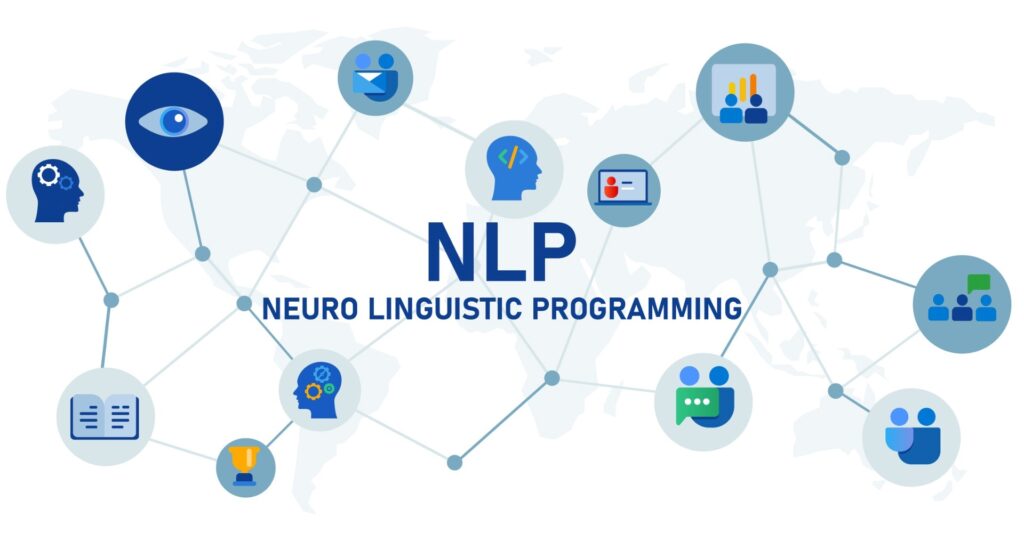The power of words and the subtlety of non-verbal cues play a pivotal role in all forms of human interaction, whether it be one-to-one communication or teaching. What some don’t know, however, is that understanding and mastering the art of communication from a scientific standpoint can transform the way we’re perceived, as well as increase our ability to influence others.
This is where Neuro-Linguistic Programming (NLP) comes in: by understanding key NLP techniques, you can harness the power of both effective and influential communication, whether it be in your personal interactions or in business settings. But what is NLP, and how can it serve you in your personal and professional life? Let’s take a closer look.
NLP Meaning: Explained
Before you go off to Google “neuro linguistic programming meaning”, let us fill you in: at its core, NLP, or Neuro-Linguistic Programming, involves the study and application of language and thought patterns to influence behaviour and mindset. Put simply, it’s a psychological approach that combines both cognitive-behavioural techniques with language strategies to enhance communication and personal development. If you’re curious about how to be a better communicator, understanding NLP techniques – and how to harness them in your day-to-day life – is the first step towards unlocking its transformative and lucrative potential.
The Foundations of NLP in Communication
The foundations of NLP are rooted in the belief that language and thought patterns shape our reality; this concept extends to the ways we interact with others and how we can influence these interactions positively. NLP techniques focus on understanding thought patterns and using them to build rapport, persuade, and motivate effectively, whether it be in personal relationships, therapy, or business negotiations. It’s also invaluable when it comes to teaching, so if you’ve ever thought about becoming a teacher or selling courses, NLP techniques can transform how you transfer knowledge to others.
NLP Techniques for Enhanced Interactions
Rapport Building
One of the fundamental NLP techniques is the art of building rapport: this often involves mirroring and matching the body language, tone, and speech patterns of the person you’re communicating with. By subtly aligning your behaviour with theirs, you create a sense of familiarity and trust, paving the way for more effective and influential communication.
Reframing Perspectives
NLP therapy often employs the technique of ‘reframing’ to shift how an individual perceives a situation: in short, by changing the language or context around a particular thought or event, you can alter its impact and meaning. This technique is particularly powerful in overcoming limiting beliefs and opening up new possibilities in thinking and interaction.
Utilising Meta-Models
NLP also uses something known as meta-models: these are tools for understanding and clarifying vague language, and can involve questioning and exploring the assumptions behind someone’s words. The aim of meta-models is to achieve – organically – a deeper understanding and resolution of communication barriers; this technique can be invaluable in both personal and professional contexts, where clear and precise communication is key.
Anchoring Emotional States
Anchoring is another NLP technique, whereby a specific emotional state is associated with a physical touch or gesture. This can be used to trigger positive emotional responses during communication, enhancing the impact of your message and your ability to persuade or motivate. For example, for those interested in teaching and teaching styles, anchoring is a great way to put students at ease, while also feeling comfortable in an authoritative role.
Chunking
This NLP technique involves breaking down large pieces of information into smaller, more manageable units, or conversely, grouping smaller elements into a larger context. Chunking helps in organising thoughts and communicating more effectively, making complex information easier to understand and remember. This technique can be particularly useful in learning environments and when trying to convey intricate concepts to an audience.
The Swish Pattern
The Swish Pattern is another NLP technique, primarily used to change undesirable habits or behaviours; this works by visualising the unwanted behaviour and then quickly ‘swishing’ it with an image of the desired behaviour. This process of mental rehearsal is said to help reprogram the brain to trigger the preferred behaviour in the situation where the unwanted behaviour usually occurs. When executed correctly, the Swish Pattern can be an effective technique for personal development, and can be used to instil positive habits, attitudes, or responses, leading to improved communication and interpersonal skills.
Future Pacing
Future pacing is a popular NLP technique where individuals are encouraged to visualise themselves successfully applying newly acquired skills or behaviours in a future scenario. Often used in one-to-one coaching, this visualisation exercise can help to reinforce learning and embed the changes more deeply within the psyche. In short, it works by mentally practising and experiencing success in a future event, allowing individuals to build confidence and be more likely to exhibit the desired behaviour when the actual situation arises. Aside from coaching, this method is also beneficial in training settings, as it not only consolidates learning but also prepares learners for real-life application.
Neuro-Linguistic Programming Meaning in Today’s World
In the increasingly digital world of 2024 and beyond, understanding neuro-linguistic programming meaning extends beyond face-to-face interactions; it’s instead about applying these principles in virtual communications, be it through email, social media, or virtual meetings. After all, the ability to influence and communicate effectively – regardless of the medium – is an increasingly sought skill after in various fields, from business and education to personal development and coaching.

